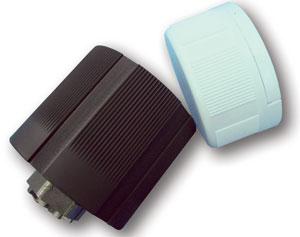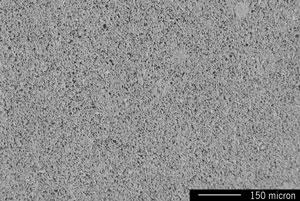- FMA
- The Fabricator
- FABTECH
- Canadian Metalworking
Graphite EDM Electrodes Work
Difficult materials and intricate configurations call for the process
- By Sue Roberts
- October 15, 2012
- Article
- Metalworking

Detailed finishing electrodes produce crisp features like the ribs on a bottle cap. Photo courtesy of POCO Graphite Inc.
The market for graphite electrodes for electrical discharge machining (EDM) has gotten smaller. High-speed, CNC milling operations have taken a chunk of the business and are doing a good job. But for applications involving materials that are difficult to machine or locations that a cutting tool can't reach, graphite electrodes with EDM offers solid solutions and works hand-in-hand with other machining processes.
Harry Burden, marketing manager at Mersen USA, St. Marys, Pa., listed some reasons that graphite remains a good choice: "It is much easier to fabricate an electrode out of graphite than other materials. Graphite electrodes offer a low coefficient of thermal expansion, good geometric stability, hold an edge, and provide a high metal removal rate. They have a low density so they weigh less, and that is a critical factor as they become larger." Overall, Burden estimates that graphite has gained as much as 90 percent of the North American EDM electrode market.
What Calls for Graphite?
"Fine, intricate details; thin ribs; thin cross sections; or applications that have a large amount of machining to achieve the electrode detail should use a fine-grain graphite for optimum performance and maximum efficiency," said Jerry Mercer, POCO Graphite Inc., an Entegris Company, in Decatur, Texas. "This would include applications such as aerospace, intricate detailed consumer items such as the ribs on a bottle cap, or applications that require crisp detail or surface finish," the manager for EDM applications and mold coatings said.
"In general, the EDM die sinking process is used to create the cavities in molds that eventually make a part out of another material. Anywhere that you can't get a cutter into a machine, you can manufacture a very small electrode and burn the feature on it," Burden said.
"The way things are fastened today, for example, has played a big part in the accuracy and complex shapes of automotive parts. Plastic panels are snapped into place with clips rather than being connected with metal screws and bolts," said Burden. "The locating pins and slots have to be very accurate. A lot of those molds are being machined using high-speed milling and then the manufacturer comes back in and uses EDM for the details that will bore the locating slots."
Burden used jet engines as another example of an industry that relies heavily on graphite EDM electrodes to create parts. "They use exotic alloys that are not very receptive to milling or grinding operations, so EDM is used to produce the many slots and keyways that are required."
What's New in Graphite?
Graphite particle size is getting smaller, and producers continuously monitor their products to ensure that users can rely on the results from their graphite electrodes not only from year to year, but from decade to decade.
Mercer said that EDM applications today typically use the three smallest grain sizes: angstrofine with a particle size of 1 micron or less; ultrafine with a particle size from 1 to 5 microns; and superfine with a particle size from 6 to 10 microns.
"As a rule of thumb," Mercer said, "as the particle size gets larger and EDM parameters remain the same, the effects you will see on the EDM performance will be increased metal removal rate, rougher surface finish, and more electrode wear. I would say that 90 percent of the EDM electrodes produced in the industry right now are in the superfine or ultrafine classification."
Consistency is at the heart of graphite production. Mercer said, "Quality means maintaining consistency in our particle size and uniformity in our microstructure—the relation between the particle size and the porosity of the graphite. To a customer, this means they will get consistent performance and can forecast their productivity based on metal removal rates or electrode wear so they know what is needed to complete a job. Needing to machine extra electrodes due to excessive wear caused by inconsistent material structure is just money off the bottom line."

An isotropic Ultrafine grain graphite offers high strength, good wear and fine surface finish characteristics. Photo courtesy of POCO Graphite Inc.
Some manufacturers are addressing the size of graphite billets to accommodate changing electrode needs. "Our ultrafine material is manufactured from a highly carbonaceous raw material," said Burden. "We originally introduced it as a 12- by 12- by 4-in. billet size. We've recently added a 4- by 12- by 24-in. size."
Which Graphite?
Particle size is first and foremost in achieving a successful EDM process. It affects the metal removal rate, surface finish, and electrode wear. There are other performance indicators such as overburn and recast that are application-specific, but they can be mitigated through EDM machine parameters.
Fine-grain materials have smaller pores and machine to a better finish that is reproduced on the workpiece. Coarser-grain materials have larger particles and pores. Increased electrode wear with larger particles creates excessive debris in the EDM gap, causing an unstable EDM process, and increases the potential of a DC arc or an adverse effect on the surface finish.
A basic correlation is that coarser-grain materials remove more material quicker and are less expensive, while fine-grain graphites provide a better surface finish in the workpiece and can have lower wear ratios than the coarser-grain materials.
"The finer finish is especially crucial with some of the new reflector and lens molds that are being made. Historically, there was a lot of bench time spent polishing these molds to get the surface finish, but that is not acceptable today because it is easy to take them out of tolerance or create waviness," said Burden. "So these customers like to get as fine a finish as possible off the EDM process to produce the needed mirror finish."
Mercer said, "We see a lot of people who will use a 10 micron to rough the cavity out. That allows them to go to the higher powers with longer on-times for removal rate and get a good replating layer that is not so thick that it will have a negative effect. They are not interested in finish at this point, so they use a large-particle-size material that is more economical. As they move down into the semifinishing or finishing stages where the electrode gets into a wear scenario, they either run a different large-particle-size electrode or switch to a finer-grain material that will allow them to operate at lower parameters for the surface finish without excessive wear."
"It is empirically difficult to identify the key characteristics of graphite to facilitate the EDM operation," Burden said. "We know that raw material selection is critical and that graphites—even with very similar properties manufactured from different raw materials—can have significantly different wear ratios."
As with other processes, graphite electrode choices should be driven by application. "When talking with someone for a material recommendation, first I ask about the application to identify the most applicable material based on the electrode detail they are going to machine and the work metal being EDMed. Then I ask about their performance indicators, what is most important to them. Even in similar applications, some people are more concerned with speed, some with electrode wear, and some focus on surface finish itself. So we take it on a case-by-case basis," said Mercer.
Can't tell
Closely track your graphite electrodes, Mercer said. "Even those of us who are very familiar with the electrode material can't tell the difference in particle size without laboratory testing."
subscribe now


Keep up to date with the latest news, events, and technology for all things metal from our pair of monthly magazines written specifically for Canadian manufacturers!
Start Your Free Subscription- Trending Articles
- Industry Events
MME Winnipeg
- April 30, 2024
- Winnipeg, ON Canada
CTMA Economic Uncertainty: Helping You Navigate Windsor Seminar
- April 30, 2024
- Windsor, ON Canada
CTMA Economic Uncertainty: Helping You Navigate Kitchener Seminar
- May 2, 2024
- Kitchener, ON Canada
Automate 2024
- May 6 - 9, 2024
- Chicago, IL
ANCA Open House
- May 7 - 8, 2024
- Wixom, MI















